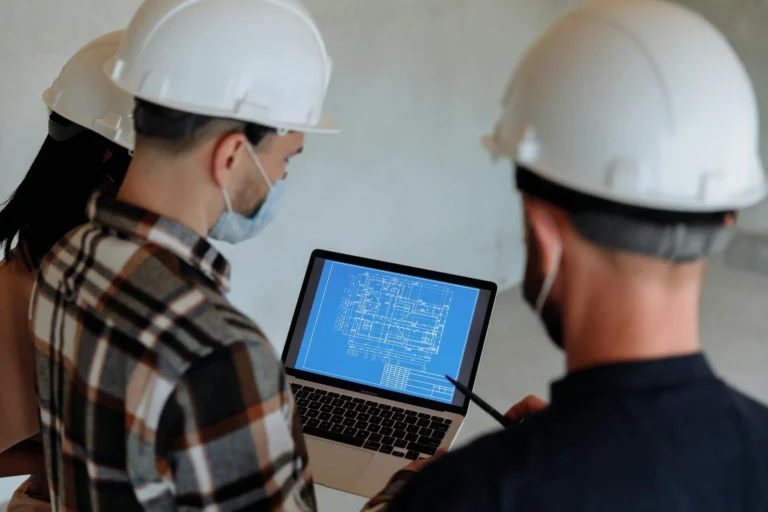
In the construction industry, decision-making is a critical component that directly impacts project outcomes. Timely, accurate, and actionable information is essential for effective decision-making, and this is where real-time data plays a transformative role. As construction projects become more complex and deadlines more stringent, leveraging real-time data has become a necessity rather than a luxury. This blog explores the multifaceted ways real-time data enhances decision-making in construction, touching on its applications, benefits, and the technologies enabling this revolution.
Real-Time Data: A Game-Changer for Construction
Real-time data refers to information that is collected, processed, and made available almost instantaneously. In the context of construction, it encompasses data from various sources, including sensors, drones, Building Information Modeling (BIM) systems, project management software, and Internet of Things (IoT) devices. Unlike traditional methods of data collection, which rely on periodic updates, real-time data provides continuous insights, enabling stakeholders to react swiftly to changing circumstances.
The construction industry has historically been plagued by inefficiencies and delays. Traditional data collection methods often result in information silos, outdated reports, and a lack of visibility into project progress. Real-time data disrupts this cycle by providing a unified, up-to-date view of the entire project lifecycle. It creates a feedback loop that empowers decision-makers to act on live information rather than retrospective analyses, significantly improving operational efficiency and project outcomes. Furthermore, the integration of real-time data into existing workflows allows for a more dynamic approach to project management, as teams can adapt to on-site challenges with unprecedented agility.
Enhancing Project Planning and Execution
One of the most significant impacts of real-time data is on project planning and execution. Accurate data is the foundation of effective planning, and real-time insights provide the granular details needed to create realistic schedules and budgets. For instance, real-time data from drones and sensors can monitor site conditions, enabling project managers to identify potential obstacles before they become critical issues. This proactive approach reduces the likelihood of delays and cost overruns, which are common challenges in large-scale construction.
The ability to monitor conditions such as weather, soil stability, and material availability in real time adds an extra layer of foresight to planning. For example, data from IoT-enabled equipment can predict equipment malfunctions, allowing teams to schedule maintenance before a breakdown disrupts the project timeline. Similarly, insights from digital models, like those created in BIM software, can help in preemptively adjusting designs to accommodate unforeseen site challenges. During the execution phase, real-time updates allow managers to evaluate performance metrics such as worker productivity and material usage. These updates provide actionable insights, enabling managers to make informed adjustments to schedules, reallocate resources, or even alter methodologies to ensure that the project remains on track.
Improving Safety and Risk Management
Safety is a top priority in construction, and real-time data has a profound impact on risk management. IoT devices and wearable technologies enable real-time monitoring of workers’ health and safety conditions. For instance, sensors can detect hazardous conditions such as high levels of dust or gas, and wearable devices can monitor workers’ vital signs, such as heart rate and body temperature. If a risk is identified, alerts can be sent instantly to supervisors, allowing for immediate action to prevent accidents or health issues.
The integration of real-time safety data doesn’t stop with individual workers. Site-wide monitoring systems can identify broader risks, such as structural instability or the improper handling of heavy machinery. Drones equipped with high-resolution cameras and thermal imaging can inspect areas that are otherwise difficult or dangerous for workers to access, such as rooftops, scaffolding, or underground installations. This capability not only ensures the safety of workers but also minimizes the chances of costly accidents that can derail a project.
Additionally, the use of real-time data extends to post-incident analysis. By collecting detailed data about near-misses and accidents as they happen, companies can conduct more effective investigations and implement targeted preventive measures. This continuous feedback loop enhances both immediate and long-term safety standards, making construction sites safer for everyone involved.
Optimizing Resource Allocation
Construction projects involve multiple resources, including labor, equipment, and materials. Inefficient allocation of these resources can lead to significant waste, increased costs, and missed deadlines. Real-time data provides the visibility needed to optimize resource allocation, ensuring that every aspect of the project is utilized effectively and that waste is minimized.
For instance, real-time tracking of equipment usage can prevent underutilization or overuse. Advanced IoT devices can monitor how frequently and intensively equipment is used, helping managers decide whether to redistribute assets, schedule maintenance, or even reduce the fleet size. Similarly, real-time monitoring of material inventories ensures that resources are neither overstocked nor understocked. For example, if a project is running low on a critical material like concrete, the system can automatically alert procurement teams, allowing for timely reordering and preventing work stoppages.
Labor allocation is another area where real-time data proves invaluable. By tracking worker attendance, productivity, and task completion rates, managers can identify inefficiencies and adjust team assignments to match the project’s evolving needs. For instance, if a particular task is progressing slower than expected, additional workers can be reassigned to accelerate progress. This level of granular control over resources not only improves efficiency but also helps ensure projects are completed within budget and on schedule.
Enhancing Collaboration and Communication

Construction projects often involve a diverse range of stakeholders, including architects, engineers, contractors, and clients. Effective collaboration and communication among these parties are crucial for project success. Real-time data fosters collaboration by providing a centralized platform where stakeholders can access up-to-date information and communicate seamlessly.
Modern project management tools integrate real-time data streams to enable transparency and accountability across teams. For instance, cloud-based platforms like Procore or Autodesk Construction Cloud allow all stakeholders to view progress reports, access shared documents, and leave comments or feedback. This instant access to information reduces the lag often associated with traditional communication methods, such as emails or weekly meetings. Real-time updates ensure that everyone remains aligned with the project’s goals, and potential conflicts or misunderstandings can be addressed promptly.
In addition to improving internal team dynamics, real-time data also enhances communication with external parties. Clients can receive regular updates on project milestones, fostering trust and satisfaction. Furthermore, real-time video feeds or dashboards can provide a live view of construction progress, allowing clients and investors to see tangible results in real time. This level of transparency not only strengthens relationships but also helps mitigate disputes and delays caused by miscommunication.
Enabling Predictive Analytics and AI Integration
One of the most exciting advancements enabled by real-time data is the integration of predictive analytics and artificial intelligence (AI). Predictive analytics uses historical and real-time data to forecast potential outcomes, while AI algorithms provide actionable recommendations based on these forecasts. This combination has the potential to revolutionize decision-making in construction.
For example, predictive analytics can identify trends in labor productivity, allowing managers to anticipate delays and take corrective action before they escalate into significant issues. AI-powered tools can analyze data from sensors to suggest optimal maintenance schedules for equipment, reducing the likelihood of unexpected breakdowns. These technologies also play a pivotal role in resource optimization by identifying patterns that human managers might overlook, such as the correlation between weather conditions and worker productivity.
Moreover, AI can assist in risk management by analyzing vast amounts of data to detect anomalies or predict potential hazards. For instance, an AI system might flag inconsistencies in structural integrity data collected from IoT sensors, prompting a deeper investigation before any issues arise. By leveraging these capabilities, construction companies can make more informed, proactive decisions that enhance efficiency, safety, and profitability.
Facilitating Sustainability and Compliance
Sustainability is becoming increasingly important in the construction industry, and real-time data plays a crucial role in achieving environmental goals. Sensors and monitoring devices can track energy consumption, water usage, and waste generation in real time. This information enables project managers to implement sustainable practices, such as optimizing energy efficiency, reducing material waste, and recycling construction debris.
For instance, IoT-enabled systems can monitor energy usage across a construction site and identify areas where consumption is excessive. Managers can then implement energy-saving measures, such as optimizing lighting schedules or upgrading to more efficient equipment. Similarly, real-time monitoring of waste streams allows teams to segregate recyclable materials more effectively, reducing the environmental impact of construction activities.
Compliance with environmental and safety regulations is another area where real-time data proves invaluable. Continuous monitoring ensures that projects adhere to legal requirements, avoiding potential fines and reputational damage. For example, sensors can detect and record emissions levels to ensure compliance with air quality standards. By integrating real-time data into compliance strategies, construction companies can demonstrate their commitment to sustainability and regulatory adherence, enhancing their reputation and competitive edge.
Overcoming Challenges in Real-Time Data Implementation
While the benefits of real-time data are undeniable, implementing such systems is not without challenges. One significant hurdle is the integration of various data sources into a cohesive platform. Construction projects generate data from numerous systems, and ensuring interoperability among these systems requires robust software solutions.
Another challenge is data security. With real-time data being transmitted across networks, protecting sensitive information from cyber threats is paramount. Construction companies must invest in secure data transmission protocols and robust cybersecurity measures to safeguard their operations. Furthermore, the cost of implementing real-time data systems can be a barrier, particularly for smaller firms. However, the long-term benefits of improved efficiency and reduced risk often outweigh the initial investment.
Finally, the adoption of real-time data systems requires a cultural shift within organizations. Workers and managers need to be trained to use new technologies effectively. Resistance to change can hinder the implementation process, so it is essential to emphasize the tangible benefits of real-time data to gain buy-in from all stakeholders. Demonstrating the positive impact of these systems on productivity, safety, and profitability can help overcome resistance and drive adoption.
The Future of Real-Time Data in Construction
As technology continues to evolve, the role of real-time data in construction is set to expand further. Innovations such as 5G networks, advanced IoT devices, and AI-powered analytics will enhance the speed and accuracy of data collection and processing. These advancements will enable construction companies to achieve new levels of efficiency, safety, and sustainability.
In the future, real-time data may also facilitate the adoption of digital twins—virtual replicas of physical construction sites. Digital twins integrate real-time data from sensors and other sources to provide a comprehensive, real-time view of a project. This technology has the potential to revolutionize construction by enabling predictive modeling, scenario analysis, and real-time optimization. Additionally, the integration of blockchain technology could enhance data security and transparency, further solidifying the role of real-time data in the industry.
Real-time data is transforming decision-making in construction projects, offering unprecedented levels of insight and control. From improving project planning and safety to optimizing resource allocation and fostering collaboration, the benefits of real-time data are vast and varied. While challenges remain, the ongoing advancements in technology and the increasing adoption of data-driven practices ensure that real-time data will continue to shape the future of construction. By embracing this powerful tool, construction companies can enhance efficiency, reduce risks, and deliver projects that meet the highest standards of quality and sustainability.
In today’s construction landscape, efficiency and accuracy are paramount. Construction management software, like Wunderbuild, revolutionises project handling by centralising tasks, from scheduling and budget management to communication and document control. This integration enhances productivity and ensures projects are completed on time and within budget, making it an essential tool for modern construction professionals. Embrace Wunderbuild here to begin streamlining your construction processes and boost your project’s profitability.




